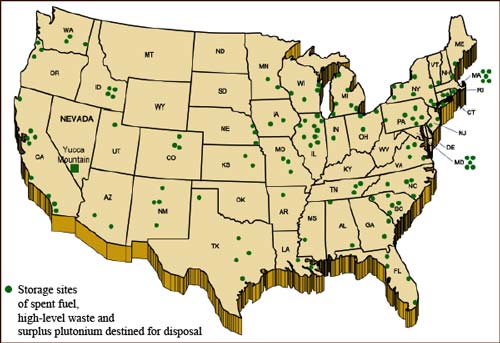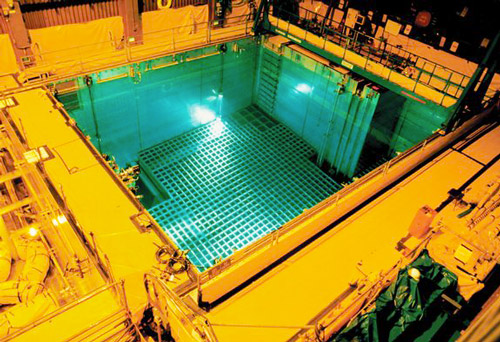The case of the greatest nuclear power

Waste disposal and storage sites in the US
In the US, spent fuel and highly radioactive waste is temporarily stored in surface facilities at 131 sites in 39 states. The majority of the storage sites are in populated areas. The dispersal of these radioactive materials contrasts with the situation in France where radioactive materials are grouped together at just a few sites. The aim of the Yucca Mountain project, which was abandoned in 2011, was to group waste in a similar way.
© DOE
Nuclear-powered US Navy vessels, past production of nuclear weapons and the current dismantling of those weapons, the generation of 20% of the nation’s electricity, and many research activities are all sources of high-level waste in the US. These materials, accumulated since the mid-1940s, are stored in surface facilities at 131 sites in 39 states, awaiting their final fate. Most of these storage sites are close to populated areas. In total, 161 million Americans live less than 75 miles from places where radioactive waste is stored.
If the storage facilities were not perpetually maintained, the radioactive materials could contaminate groundwater and surface water. Those materials would present a serious risk for humans and for the environment if they were left there indefinitely.
A DOE (Department of Energy) brochure explaining to the public the need to build a large radioactive waste disposal facility at Yucca Mountain in the Nevada Desert explained that this disposal facility would bring together all the highly radioactive waste described in the inventory. The distance of 75 miles mentioned above is the distance between Yucca Mountain and Las Vegas, the nearest city. The 161 million Americans living less than 75 miles from places where radioactive waste is stored are closer to those storage sites than the residents of Las Vegas would have been to the future waste disposal facility at Yucca Mountain.
The production of nuclear weapons during the Second World War and the Cold War are the origin of a legacy of high-level waste and military spent fuel stored in Washington State, South Carolina, Colorado and Idaho. Large volumes of high-level waste were generated in the past during the reprocessing of spent fuels to extract the plutonium from nuclear weapons. Highly radioactive waste from reprocessing is sometimes in liquid form (in some cases tanks have leaked). The federal sites where this waste is stored need to sort this out. When the time comes to clean up and dismantle sites formerly used for the manufacture of nuclear weapons, it will be necessary to dispose of those materials safely and permanently.
The end of the Cold War brought with it the welcome challenge of eliminating the surplus weapons-grade plutonium that was no longer necessary for national security. The surplus plutonium can be mixed with uranium oxide in fuels that can be burned in reactors. By disposing permanently of its surplus weapons-grade fissile materials, the US would encourage other nations to do the same.

Spent fuel storage pool
Pools near nuclear power plants are used in the US for storing the highly radioactive spent fuel unloaded from reactors. Some facilities have a limited storage capacity. Once they are full, more space has to be found for storage. The extra costs of dry storage on power plant sites and of the necessary safety measures accompanying this storage are rapidly increasing.
© NRC
The DOE (Department of Energy) has supplied nuclear fuel to research reactors in the US and abroad. To comply with non-proliferation treaties, these research centres have to return the nuclear fuel they use because it remains the property of the DOE. These spent fuels are stored at the Savannah River site in South Carolina and at the National Engineering and Environmental Laboratory in Idaho until they can be sent to a disposal facility. Storage capacity at reactor sites is limited and the saturation of such facilities can lead to the premature closure of a reactor.
Other articles on the subject « Waste Inventory »
Recoverable materials
Inventory of reusable uranium and plutonium stocks The radioactive species present in the spent f[...]
France: waste panorama (1)
An overview of French waste categories… In France, radioactive waste is split into five cat[...]
France: waste panorama (2)
An overview of French waste categories (continued)… Low- and intermediate-level short-lived[...]
Various radioactive waste
Radioactive waste from many different sources… When radioactive waste is mentioned, people [...]
Mining residues
Waste from uranium extraction The residues from processing uranium ores are disposed of on the si[...]
Medicine and research
Radioactive sources, producers of waste outside the nuclear industry… Biology labora[...]
Military waste
A separate system Using the gaseous diffusion process, the AREVA Pierrelatte facility produced en[...]
Radium-bearing waste
Legacy waste – weakly radioactive but long-lived Recent and less recent industrial activities hav[...]
Waste from Dismantling
Dismantling of facilities: graphite waste Experience with dismantling nuclear power plants is onl[...]
Waste from Industry
Obsolete radioactive sources, the legacy of radium applications There are numerous industrial app[...]